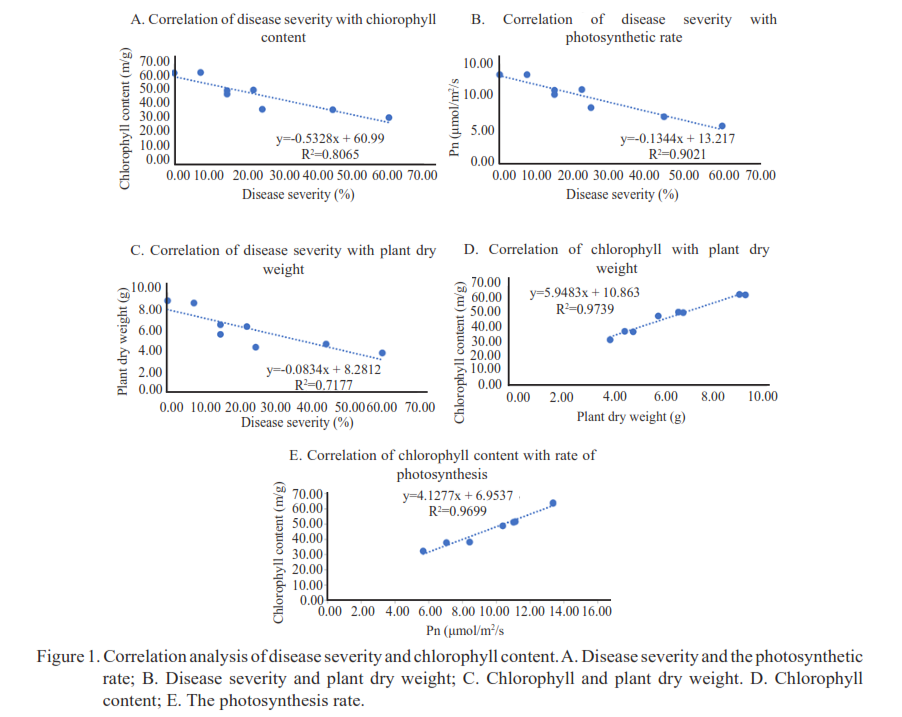Maize induced resistance against downy mildew mediated by benzoic acid increased photosynthesis rate and chlorophyl content
Main Article Content
Abstract
Maize downy mildew, caused by Peronosclerospora spp., is a major disease affecting maize cultivation in tropical regions, particularly in Indonesia. One potential control strategy is the induction of plant resistance. Previous studies have demonstrated that benzoic acid (BA), a non-fungicidal chemical compound, can induce maize resistance against downy mildew. Induced resistance mechanisms do not directly inhibit pathogen development but enhance the plant’s defensive response to infection. This study utilized various maize lines, ranging from susceptible to resistant, to evaluate the impact of BA-induced resistance on photosynthesis rate and chlorophyll content as the key agronomic parameters associated with the plant growth. The results showed that BA treatment did not significantly increase the photosynthetic rate and chlorophyll content in moderately resistant and resistant maize lines. However, in susceptible and moderately susceptible lines, BA treatment enhanced both parameters, indicating its role in strengthening plant resistance. These findings suggest that resistant maize lines do not respond to BA induction, whereas susceptible and moderately susceptible lines benefit significantly from its application. This provides new insight that BA can potentially induce resistance in susceptible maize plants against downy mildew.
Article Details

This work is licensed under a Creative Commons Attribution-NonCommercial 4.0 International License.
References
Agustamia C, Widiastuti A, & Sumardiyono C. 2016. Pengaruh stomata dan klorofil pada ketahanan beberapa varietas jagung terhadap penyakit bulai [Stomata and chlorophyl’s influence on the resistance of several maize varieties against downy mildew]. Indones. J. Plant Prot. 20(2): 89–94. https://doi.org/10.22146/jpti.17703
Arnon, D.I.1949. Copper Enzymes in Isolated Chloroplasts. Polyphenoloxidase in Beta Vulgaris. Plant Physiology. 24, 1–15. https://doi.org/10.1104/pp.24.1.1
Ashraf M, Akram NA, Al-Qurainy F, & Foolad MR. 2011. Chapter five - Drought Tolerance: Roles of Organic Osmolytes, Growth Regulators, and Mineral Nutrients. In: Sparks DL (Ed). Adv Agron. 111: 249–296. https://doi.org/10.1016/B978-0-12-387689-8.00002-3
Cham AK, Ojeda-Zacarías MdC, Lozoya-Saldaña H, Olivares-Sáenz E, Alvarado-Gómez OG, & Vázquez-Alvarado RE. 2022. Effects of elicitors on the growth, productivity and health of tomato (Solanum lycopersicum L.) under greenhouse conditions. J. Agr. Sci. Tech. 24(5): 1129–1142.
Gao X, Xin D, Zhao Y, Li J, Cao Y, Zhang S, & Guo J. 2024. Potential molecular mechanism of photosynthesis regulation by PeMPK7 in poplar under para-hydroxybenzoic acid stress, Ecotoxicol. Environ. Saf. 276: 116329. https://doi.org/10.1016/j.ecoenv.2024.116329
Enciso ELG, Olivo AR, Mendoza AB, Gaona SS, & Morales SG. 2018. Effect of elicitors of natural origin on tomato plants subjected to biotic stress. Rev. Mexicana Cienc. Agríc. 20: 4211–4221. https://doi.org/10.29312/remexca.v0i20.991
Habibullah M, Widiastuti A, & Sumardiyono C. 2018. Respons awal ketahanan jagung terhadap Peronosclerospora maydis dan induksi bahan kimia [Early response of maize resistance to Peronosclerospora maydis and chemical induction]. Indones. J. Plant Prot. 22(1): 27–32. https://doi.org/10.22146/jpti.26877
Habibullah M, Sumardiyono C, & Widiastuti A. 2020. Potency of non-fungicide chemicals for maize inducing resistance against downy mildew. Indones. J. Plant Prot. 24(2): 154–160. https://doi.org/10.22146/jpti.55057
Hussain A, Noureen A, Shoukat W, Hussain S, Ali F, Ujjan JA, Memon FS, & Bapar NA. 2021. Mitigating the effect of salinity stress through foliar application of benzoic acid in spring maize (Zea mays. L). Elementary Education Online. 20(5): 7707–7712. https://doi.org/ 10.17051/ilkonline.2021.05.874
Latifa R, Hadi S, & Nurrohman E. 2019. The exploration of chlorophyll content of various plants in city forest of Malabar Malang. Bioedukasi. 17(2): 50–61. https://doi.org/10.19184/bioedu.v17i2.14091
Muis A, Ryley MJ, Tan YP, Suharjo R, Nonci N, Danaatmaja Y, Hidayat I, Widiastuti A, Widinugraheni S, Shivas RG, & Thines M. 2023. Peronosclerospora neglecta sp. nov.—a widespread and overlooked threat to corn (maize) production in the tropics. Mycol. Progress. 22: 12. https://doi.org/10.1007/s11557-022-01862-5
Rakib MRM, Borhan AH, & Jawahir AN. 2019. The relationship between SPAD chlorophyll and disease severity index in Ganoderma-infected oil palm seedlings. J. Bangladesh Agril. Univ. 17(3): 355–358. https://doi.org/10.3329/jbau.v17i3.43211
Rashid Z, Zaidi PH, Vinayan MT, Sharma SS, & Setty TAS. 2013. Downy mildew resistance in maize (Zea mays L.) across Peronosclerospora species in lowland tropical asia. Crop Prot. 43: 183–191. https://doi.org/10.1016/j.cropro.2012.08.007
Mandal R & Dutta G. 2020. From photosynthesis to biosensing: Chlorophyll proves to be a versatile molecule. Sens. Int. (1): 100058. https://doi.org/10.1016/j.sintl.2020.100058
Senaratna T, Merritt D, Dixon K, Bunn E, Touchell D, & Sivasithamparam K. 2003. Benzoic acid may act as the functional group in salicylic acid and derivatives in the induction of multiple stress tolerance in plants. Plant Growth Regul. 39(1): 77–81. https://doi.org/10.1023/A:1021865029762
Sharma P, Jha AB, Dubey RS, & Pessarakli M. 2012. Reactive oxygen species, oxidative damage, and antioxidative defense mechanism in plants under stressful conditions. J. Bot. 2012(1): 217037. https://doi.org/10.1155/2012/217037
Sumardiyono C. 2008. Ketahanan jamur terhadap fungisida di Indonesia [Resistance of fungi against fungicide in Indonesia]. Indones. J. Plant Prot. 14(1): 1–5.
Surendran A, Siddiqui Y, Manickam S, & Ali A. 2018. Role of benzoic and salicylic acids in the immunization of oil palm seedlings-challenged by Ganoderma boninense. Ind. Crop. Prod. 122: 358–365. https://doi.org/10.1016/j.indcrop.2018.06.005
Widyawati N, Herawati MM, Kurnia TD, Murdono D, Simanjuntak BH, & Setiawan AW. 2023. Kandungan klorofil, pertumbuhan dan hasil vertikultur padi (Oryza sativa L.) varietas Situ Bagendit [Chlorophyll content, growth, and yield of verticulture rice plants (Oryza sativa L.) variety of Situ Bagendit]. Vegetalika. 12(3): 256–271. https://doi.org/10.22146/veg.83196

